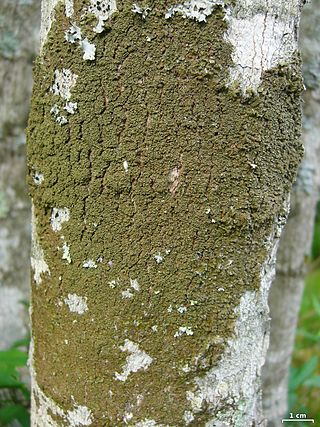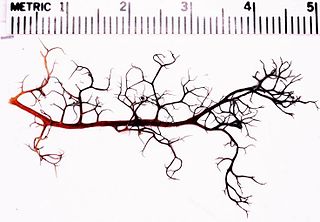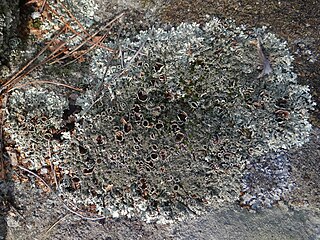
Lichenology is the branch of mycology that studies the lichens, symbiotic organisms made up of an intimate symbiotic association of a microscopic alga with a filamentous fungus. Lichens are chiefly characterized by this symbiosis.

Usnea is a genus of mostly pale grayish-green fruticose lichens that grow like leafless mini-shrubs or tassels anchored on bark or twigs. The genus is in the family Parmeliaceae. It grows all over the world. Members of the genus are commonly called old man's beard, beard lichen, or beard moss.

Parmelia is a genus of medium to large foliose lichens. It has a global distribution, extending from the Arctic to the Antarctic continent but concentrated in temperate regions. There are about 40 species in Parmelia. In recent decades, the once large genus Parmelia has been divided into a number of smaller genera according to thallus morphology and phylogenetic relatedness.

The Parmeliaceae is a large and diverse family of Lecanoromycetes. With over 2700 species in 71 genera, it is the largest family of lichen-forming fungi. The most speciose genera in the family are the well-known groups: Xanthoparmelia, Usnea, Parmotrema, and Hypotrachyna.

Pseudephebe is a genus of fruticose lichens in the family Parmeliaceae. It contains three species that grow on rocks.

Hypogymnia is a genus of foliose lichens in the family Parmeliaceae. They are commonly known as tube lichens, bone lichens, or pillow lichens. Most species lack rhizines that are otherwise common in members of the Parmeliaceae, and have swollen lobes that are usually hollow. Other common characteristics are relatively small spores and the presence of physodic acid and related lichen products. The lichens usually grow on the bark and wood of coniferous trees.

Vulpicida is a genus of lichenized fungi in the family Parmeliaceae. Circumscribed in 1993 to contain species formerly placed in Cetraria, the genus is widespread in Arctic to northern temperate regions, and contains six species. The genus is characterized by the presence of the secondary metabolites pulvinic acid and vulpinic acid, compounds that when combined with usnic acid, give the species their characteristic yellow and green colors.

Melanohalea is a genus of foliose lichens in the family Parmeliaceae. It contains 30 mostly Northern Hemisphere species that grow on bark or on wood. The genus is characterised by the presence of pseudocyphellae, usually on warts or on the tips of isidia, a non-pored epicortex and a medulla containing depsidones or lacking secondary compounds. Melanohalea was circumscribed in 2004 as a segregate of the morphologically similar genus Melanelia.

Gowardia is a genus of medium-sized, greyish hair lichens in the family Parmeliaceae. It is a circumpolar genus, mainly restricted to arctic-alpine habitats in northern Canada, Europe, and Russia.

Cornicularia is a genus of lichenised ascomycetes in the large family Parmeliaceae. It is a monotypic genus, with a single currently accepted species, the saxicolous lichen Cornicularia normoerica. This species has an erect caespitose growth form, and is sometimes referred to as the brittle lichen.

Bryoria is a genus of lichenized fungi in the family Parmeliaceae. Many members of this genus are known as horsehair lichens. The genus has a widespread distribution, especially in boreal and cool temperate areas.
Coelopogon is a genus of lichen-forming fungi in the family Parmeliaceae. The genus contains two species found in southern South America and South Africa.

Xanthoparmelia conspersa, commonly known as the peppered rock-shield, is a foliose lichen and the type species of genus Xanthoparmelia. It is widely distributed in temperate zones, and has been recorded from Japan, Europe, Africa, North America, and South America.

Calicium trabinellum, commonly known as the yellow-collar stubble lichen, is a widespread species of pin lichen in the family Caliciaceae. It was first described by Swedish lichenologist Erik Acharius in 1803 as Calicium xylonellum ß trabinellum. He made the new combination Calicium trabinellum in a later chapter of the same publication.
Punctelia ulophylla is a species of foliose lichen in the family Parmeliaceae. It is found in Europe, where it grows on the bark of a variety of trees.
Bryoria kockiana is a species of horsehair lichen in the family Parmeliaceae. It is found in North America, where it grows from the branches of conifer trees.

Gowardia zebrina is a rare species of fruticose lichen in the family Parmeliaceae. Found in Canada, it was formally described as a new species in 2020 by lichenologists Trevor Goward and Leena Myllys. The type specimen was collected by Goward on Mount Cain at an altitude of 1,440 m (4,720 ft). Here the lichen was found growing on the lower branches of a hemlock tree. The specific epithet zebrina refers to the diagnostic alternating pale and dark banding pattern of the terminal branches. The lichen has a limited distribution, as it is only known to occur in coastal northwest North America, extending from the Insular Mountains of southern Vancouver Island north to Hazelton. Its preferred habitat is in open, wind-scoured old growth forests, and its preferred substrate is the trunks and lower branches of conifer trees like fir and hemlock.
Gowardia arctica is a species of terricolous (ground-dwelling), fruticose (bushy) lichen in the family Parmeliaceae. Found in arctic regions of Northern Canada and Russia, it was formally described as a new species in 2009 by Pekka Halonen, Leena Myllys, Saara Velmala, and Heini Hyvärinen. The type specimen was collected from Banks Island in Swan Lake ; here, at an elevation of 100 m (330 ft), it was found growing among mesic mountain heath. It also occurs along the Arctic Ocean coast of Russia. The lichen is richly branched, black to black-brown in colour, and reaches up to 13 cm (5.1 in) in diameter. It contains alectorialic acid and two other unknown lichen products.

Sulcaria spiralifera is a species of fruticose lichen in the family Parmeliaceae. It is found in the northwestern United States, where it grows as an epiphyte, hanging from a variety of tree species in open or shaded maritime forests.

Lethariella canariensis is a species of fruticose lichen in the family Parmeliaceae. It was first formally described as a new species in 1810 by Swedish lichenologist Erik Acharius, as Alectoria canariensis. After having been transferred to several genera in its taxonomic history, it was placed in the genus Lethariella by Hildur Krog in 1976. It occurs on the Canary Islands.

















